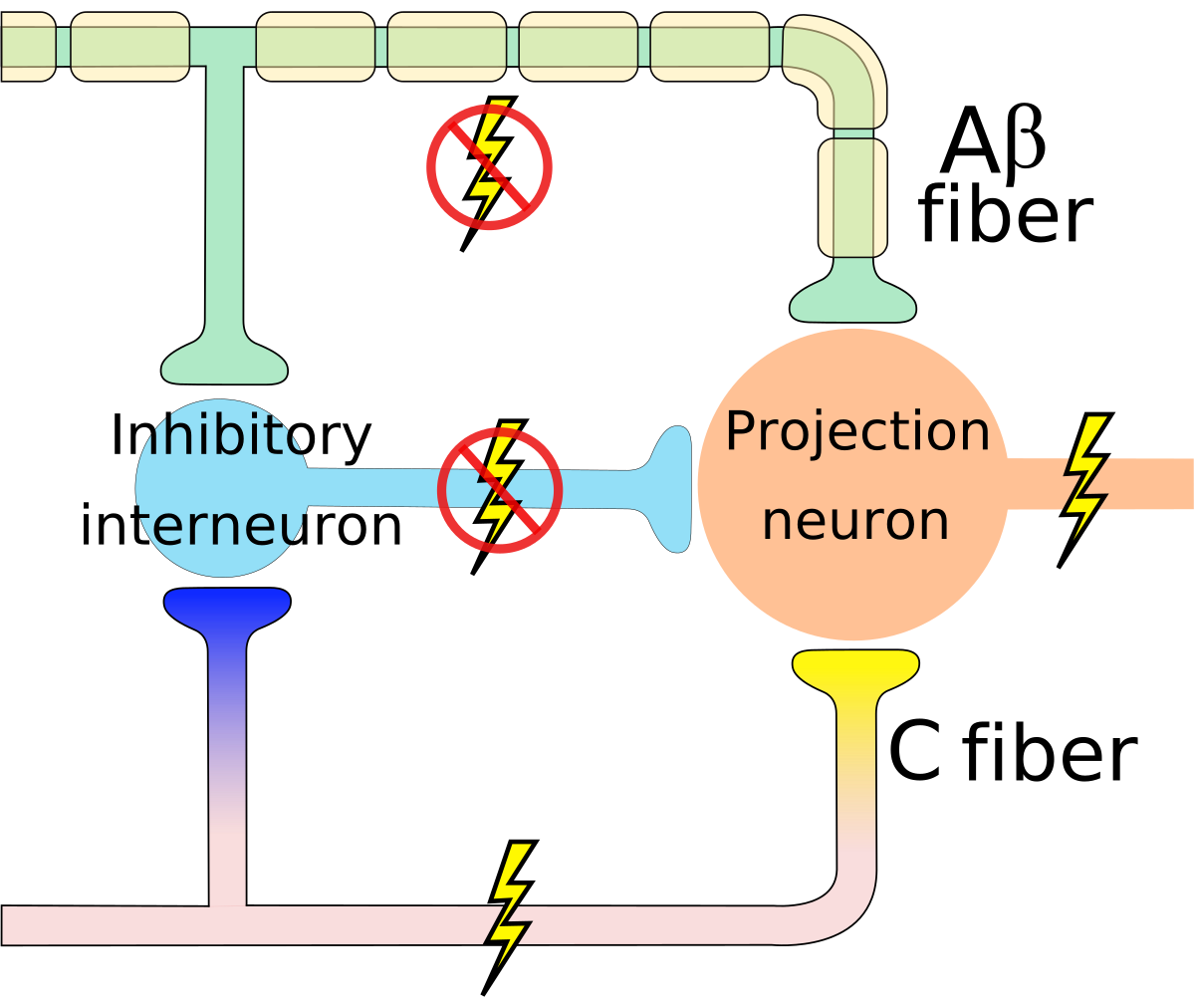- Somatosensation
- Exteroception via
- Cutaneous receptors + proprioception
- Interoception via
- Widely distributed receptors
- Specific and non-specific
- Exteroception via
2019-03-26 07:43:28
Prelude I (5:56)
Prelude II (4:56)
Today's Topics
- Sensory systems
- Somatosensation
- Pain
- Blog 2 post due Thursday
Exam grading
- Exam 1 points: 20 (everyone) + 10 (added to Quiz 2) + 10 (added to Exam 2)
- Exam 2 points: 40
- Exam 3 points: 40 (forthcoming)
- Exam 4 points: 40 (forthcoming)
- Count top 3 of 4.
Systems/information processing view
- Input
- Processing
- Memory
- Output
Let's design the Galaxy 20/iPhone XX
- What information do your users need to acquire?
- Why do they need to know it? In what context, for what purpose?
- What do they need to know about it?
- What types of information does your device need to gather, through which channels?
You vs. Your Smartphone
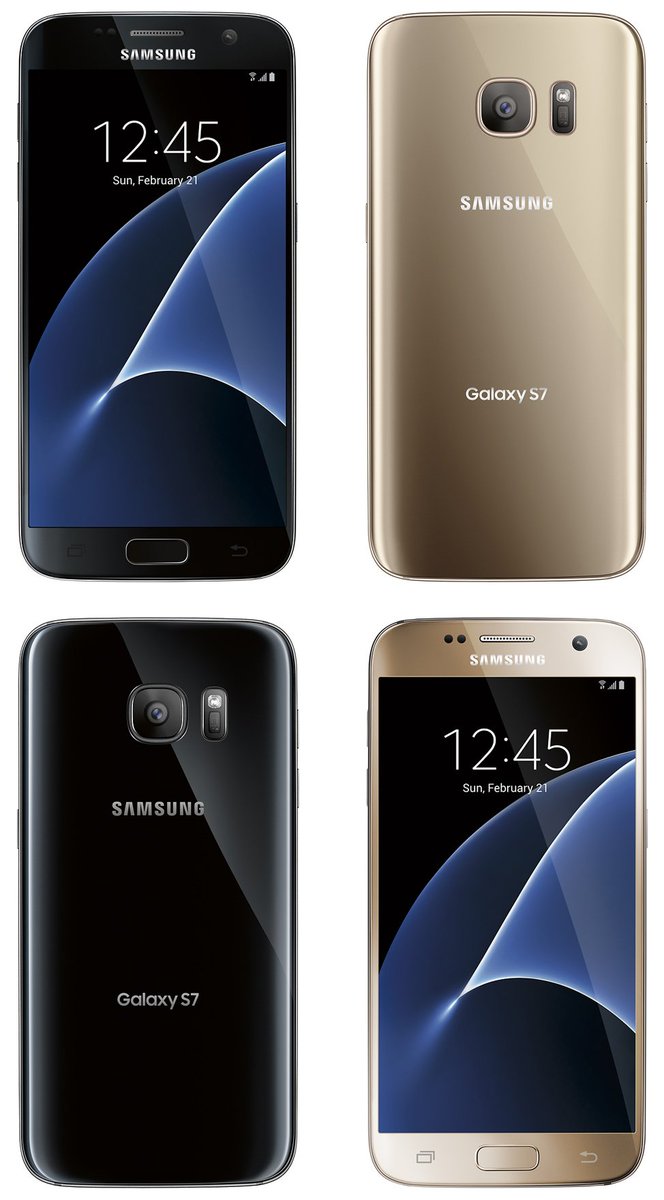
Multisensory processing in a smartphone
- Accelerometer
- Gyroscope
- Magnetometer
- Proximity sensor
- Ambient light sensor
- Barometer
Multisensory processing in a smartphone
- Thermometer
- Mic
- Camera
- Radios (Bluetooth, wifi, cellular, GPS)
Dimensions of sensory processing
- Interoceptive
- How am I?
- Exteroceptive
- What's in the world, where is it?
Questions for interoception
- Tired or rested?
- Well or ill?
- Hungry or thirsty or sated?
- Stressed vs. coping?
- Emotional state?
Questions for exteroception
- Who/What is out there?
- Where is it?
Who/what
- Animate/inanimate?
- Conspecific (same species)/non?
- Threat/non?
- Familiar/un?
- Mate/non? or Friend/not?
- Food source/non?
Where
- Distance
- Elevation, azimuth
- Coordinate frames
- Self/ego (left of me)
- Object (top of object)
- Allo/world (North of College Ave)
- Where moving?
How
- What kind of response?
- External
- Internal
- Approach/avoid/freeze
- Signal/remain silent
- Manipulate
More than 5 senses
How sensory channels differ
- What is the energy/chemical source
- How does the channel inform
- What is out there
- Where it's located
Features of sensory signals
- Tonic (sustained) vs. phasic (transient) responses
- Adaptation
- Decline in sensitivity with sustained stimulation
- Most sensory systems attuned to change
- Information propagates at different speeds
Common principles
- Sensors detect repeating signals
- In space (textures)
- In time
Spatial frequency/contrast sensitivity
Frequencies in sound
Common principles
- Compare (>1) sensor for each channel
- Eyes
- Ears
- Nostrils
- Skin surface
Why is the snake's tongue forked?
Common principles
- Sensory neurons have "receptive fields"
- Area on sensory surface that when stimulated changes neuron's firing
Tactile receptive field
Visual receptive field
Common Principles
- Topographic maps
Tonotopic (frequency) maps in auditory cortex
Retinotopic maps in visual cortex
Common principles
- Non-uniform sensitivity
Two-point touch thresholds
Acuity variations across visual field
Hearing threshold varies across frequency
Hierarchical processing
Parallel processing
Parallel processing
Types of somatosensation
- Internal (interoceptive)
- Where am I? How do I feel?
- Proprioception
- External (exteroceptive)
- What’s in the world?
- Where is it?
Internal senses
- Vestibular sense
- Head position (relative to gravity)
- Head movement (rotation, translation)
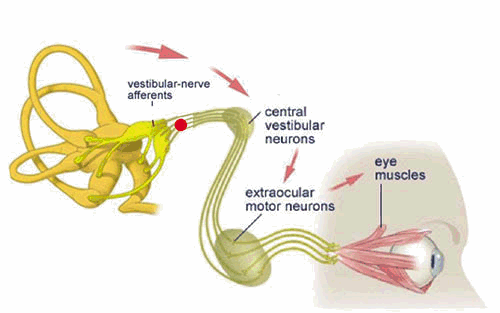
Internal senses
- Kinesthesia
- Body position
- Movement
- Pain
External senses
- Cutaneous senses (touch)
- Hot, cold
- Pressure
- Vibration
- Damage (pain)
- Plus kinesthesia (why?)
Cutaneous receptors
Receptors specialize
Combined thermo and chemo receptors
- Why are spicy foods hot?
- Why are minty foods cool?
Combined thermo and chemo receptors
- Menthol/mint receptor (CMR1)
- Also signals "cool"
- Vanilloid Receptors (VR1, VRL1)
- Also signal "hot
- Capsaicin
Menthol & vanilloid receptors
Size/speed trade-off
From skin to brain
- Cutaneous receptors
- Dorsal root ganglion
- Ventral posterior lateral thalamus
- Primary somatosensory cortex (S1)
- Parietal lobe
Dermatomes
Dermatomes
Functional segregation
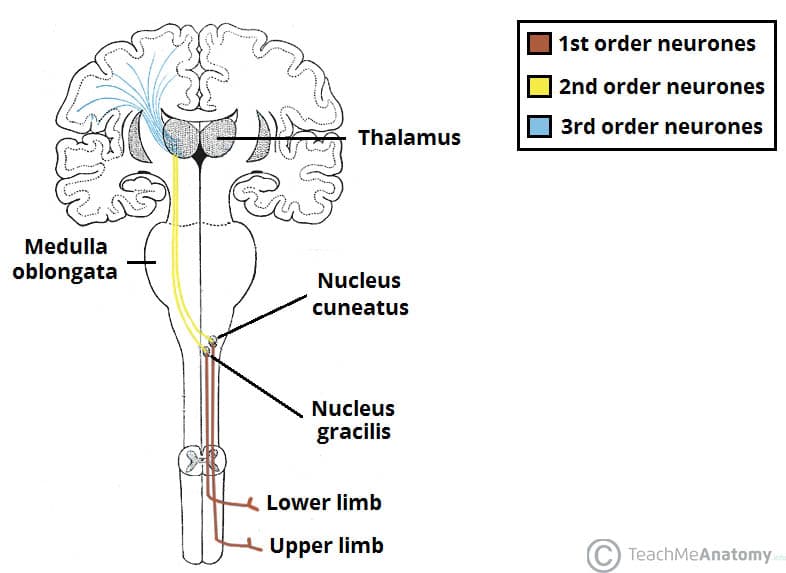
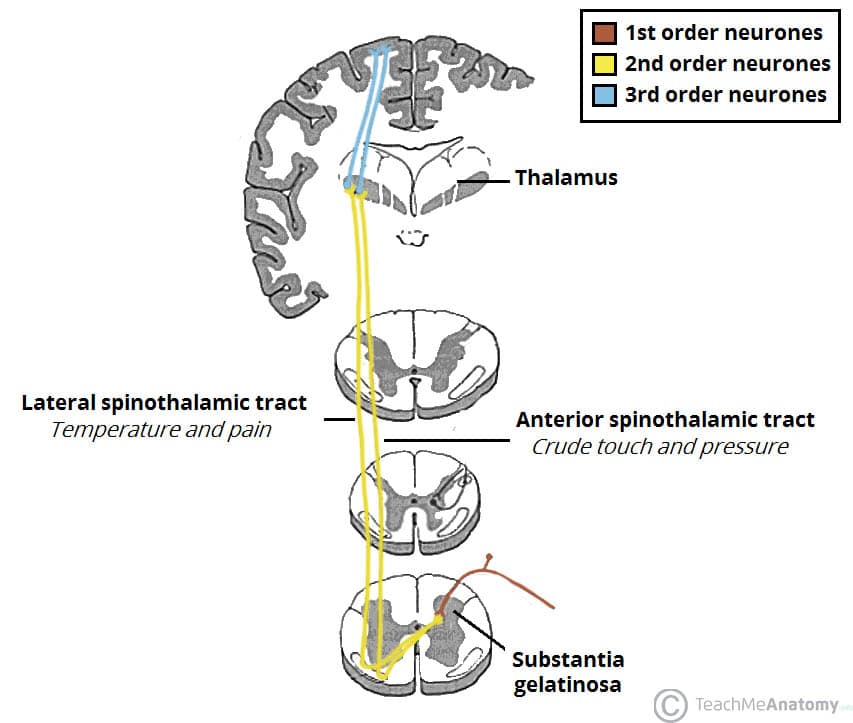
Functional segregation
- Dorsal column/medial leminiscal pathway
- Touch, proprioception
- Spinothalamic tract
- Pain, temperature
Somatatopic maps
Non-uniform mapping of skin surface
n
Non-uniform mapping of skin surface
Columnar organization/functional segregation
Phantom Limbs
What/where
- Perceiving Where
- Somatotopic maps – where on skin
- Kinesthesia – configuration of limbs
- Perceiving What
- Patterns of smoothness, roughness, shape, temperature
Somatosensation in other animals

Size/speed trade-off
The neuroscience of pain
- Nociceptors (Latin nocere to harm or hurt) detect harmful or potentially harmful stimuli of varied types:
- chemical
- mechanical
- thermal
Nociception
- External
- Skin, cornea (eye), mucosa
- Internal
- Muscles, joints, bladder, gut
Interoception
- Receptors for
- metabolism (acidic pH, hypoxia, …)
- cell rupture (ATP and glutamate)
- cutaneous parasite penetration (histamine)
- mast cell (white blood cell) activation (serotonin, bradykinin, …)
- immune and hormonal activity (cytokines and somatostatin)
Fast (\(A\delta\)) and slow (\(C\)) transmission to CNS
Thermal grill illusion

'Cross-talk' between nociceptor channels
Projection to brain via anterolateral system

Key CNS nodes in network
- Periaqueductal grey (PAG)
- Insular cortex (insula)
- Hypothalamus
- Amygdala
Key CNS nodes in network
- Thalamus
- Ventroposterior lateral nucleus
- Ventroposterior medial nucleus
- Ventromedial nucleus
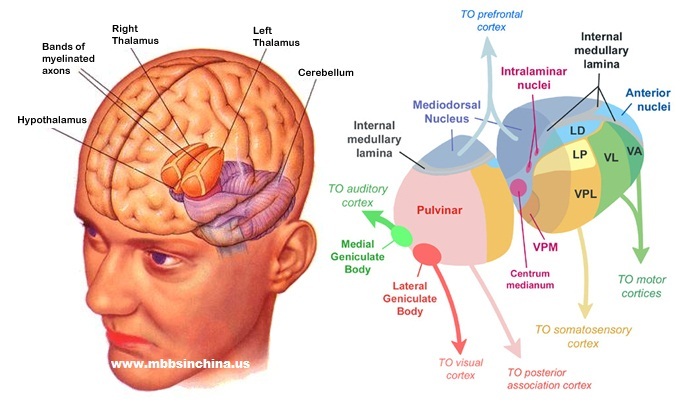
Pain in the brain
Pain in the brain
"…we used machine-learning analyses to identify a pattern of fMRI activity across brain regions — a neurologic signature — that was associated with heat-induced pain. The pattern included the thalamus, the posterior and anterior insulae, the secondary somatosensory cortex, the anterior cingulate cortex, the periaqueductal gray matter, and other areas…"
Pain relief
- Prostaglandins
- hormone-like effects, but released in many places
- trigger vasodilation and inflammation
Pain relief
- Paracetymol (acetaminophen)
- Mechanism not fully understood
- inhibits synthesis of prostaglandins via cyclooxygenase (COX) enzyme
- may modulate endocannabinoid system
- Nonsteroidal anti-inflamatory drugs (NSAIDs): aspirin, ibuprofen
- Also inhibit prostaglandins via COX
Pain relief
- Opioids
- Activate endogenous opioid systems
- multiple receptor types (\(\delta\), \(\kappa\), \(\mu\),…)
- peripheral sensory neurons, amygdala, hypothalamus, PAG, spinal cord, cortex, medulla, pons,…
- brainstem opioid neurons provide descending inhibition of nociceptors


Pain relief
- Capsaicin
- Binds to TRPV1 receptor in thermo/nociceptors
- Alters how peripheral neuron responds to mechanical stimulation
- (Borbiro, Badheka, and Rohacs 2015)
Pain relief
- Why rubbing can help
Gate control theory (Melzack and Wall 1965)
Gate control theory (Melzack and Wall 1965)
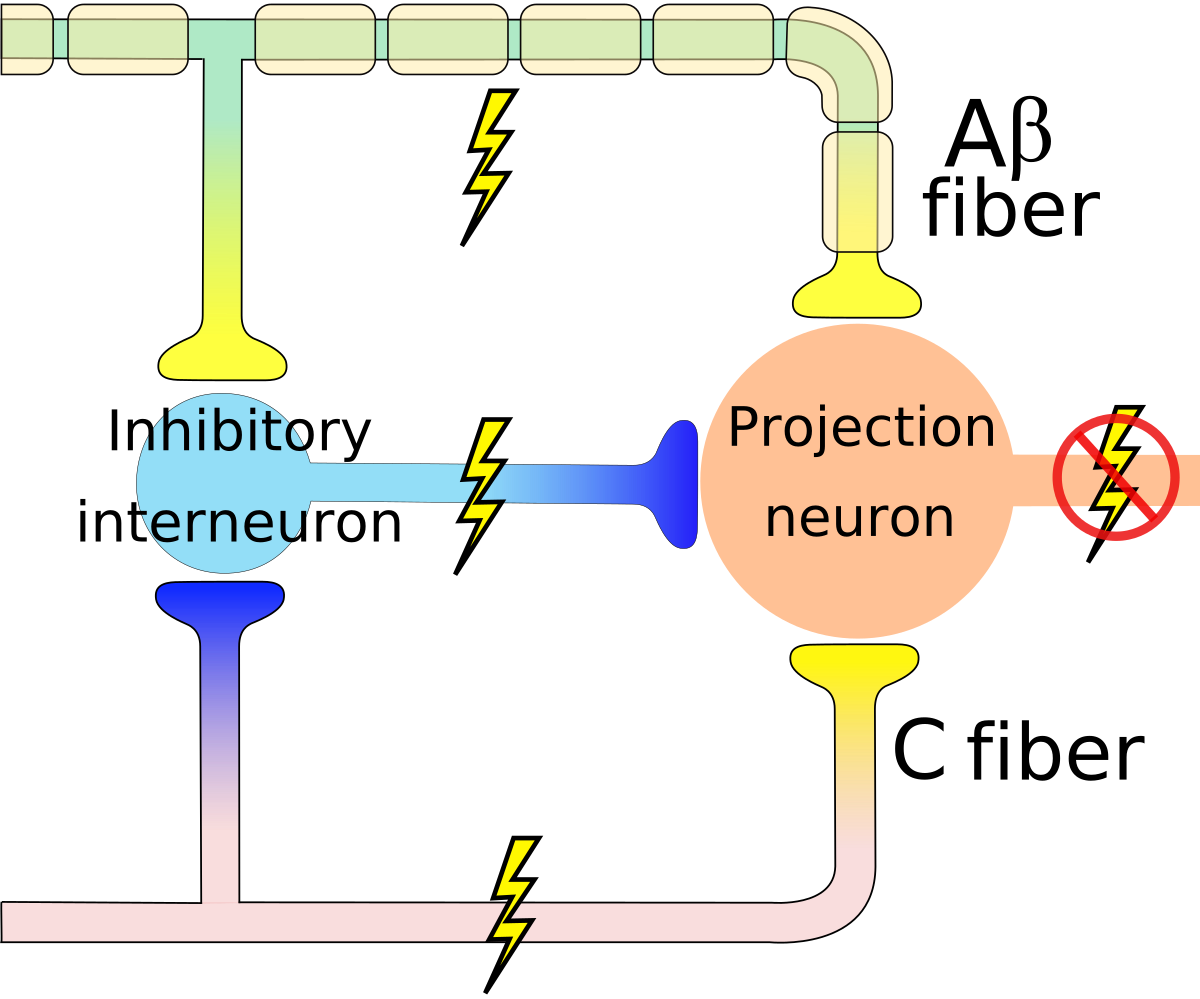
By self - self-made in Inkscape, CC BY-SA 3.0, Link
Psychological and physical dimensions
Main points
Main points
- Pain
- Multiple receptor channels
- Highly interconnected CNS network
- Multiple targets for modulation
Next time…
- Action!
References
Borbiro, Istvan, Doreen Badheka, and Tibor Rohacs. 2015. “Activation of Trpv1 Channels Inhibits Mechanosensitive Piezo Channel Activity by Depleting Membrane Phosphoinositides.” Sci. Signal. 8 (363): ra15. doi:10.1126/scisignal.2005667.
Craig, A D. 2002. “How Do You Feel? Interoception: The Sense of the Physiological Condition of the Body.” Nat. Rev. Neurosci. 3 (8): 655–66. doi:10.1038/nrn894.
Melzack, R, and P D Wall. 1965. “Pain Mechanisms: A New Theory.” Science 150 (3699): 971–79. doi:10.1126/science.150.3699.971.
Papini, Mauricio R, Perry N Fuchs, and Carmen Torres. 2015. “Behavioral Neuroscience of Psychological Pain.” Neurosci. Biobehav. Rev. 48 (January): 53–69. doi:10.1016/j.neubiorev.2014.11.012.
Wager, Tor D, Lauren Y Atlas, Martin A Lindquist, Mathieu Roy, Choong-Wan Woo, and Ethan Kross. 2013. “An fMRI-based Neurologic Signature of Physical Pain.” N. Engl. J. Med. 368 (15): 1388–97. doi:10.1056/NEJMoa1204471.











